When the Toyota Prius hybrid came out more than 20 years ago (yep, it’s been that long ago) it made a point of not looking like other cars.
So did the first electric cars, notably those made by Tesla. They were shaped differently – and they lacked the grilles that cars have (up to now) always had.
The idea was to both be and look different.
The electric version of the Genesis G80 aims to be one of the two.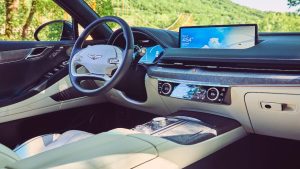
What It Is
The G80 is a mid-sized luxury sedan sold by Genesis, which is Hyundai’s luxury line (analogous to Lexus, which is Toyota’s luxury line).
The electric G80 is the same thing, just without an engine.
It’s hard to tell the difference, by looking. Or even by looking under the hood (more follows about that, below).
The biggest difference is price – which is a function of it being both electric and loaded, as the G80 electric is sold in only one trim that’s roughly comparably equipped, in terms of amenities, to the non-electric G80 3.5T Sport trim, which stickers for $65,750.
The electric version of the same thing stickers for $79,825.
It competes with other same-sized EVs that look like EVs, such as the Mercedes EQE (reviewed here) and Tesla Model S, both of which cost significantly more ($94,990 for the Tesla S; $85,900 for the power-performance comparable version of the Benz, the $85,900 EQE 500).
This is the first year you can buy an electric G80.
What’s Good
It doesn’t make a big deal about looking electric.
Offers much better performance than comparably priced electrics like the $74,900 Benz EQE 350 while costing tens of thousands less than better-performing EVs like the Tesla S.
Everything but one thing is standard.
What’s Not So Good
Much less cargo-capacity than Tesla S.
Significantly less rearseat legroom than Benz EQE.
The panorama sunroof that’s standard in the non-electric G80 3.5T Sport isn’t available with the electric G80.
This EV actually does have something under its hood – that isn’t just storage space (as in the “frunk” of most other EVs).
It almost looks like an engine, too.
Or at least the black plastic cover does. It’s very much like the black plastic covers that cover up most new car engines, which may well be deliberate in that it blurs the differences between engines and motors.
At any rate, under that cover is one of two electric motors, fed power by an 87.2 kilowatt-hour battery pack. Like the engine’d G80 3.5T, the electric G80 comes standard with AWD; the other motor – which you can’t see – drives the rear wheels.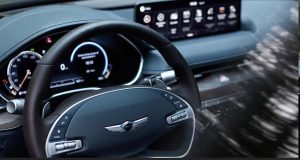
Directly – up front and out back. Like most EVs, there is no transmission; power goes from the motors to the wheels without any intermediary.
Depending on the Drive mode you select, the electric G80 is capable of getting to 60 in as little as 4.9 seconds (in Sport mode) which makes it quicker than the price-comparable Mercedes EQE 350 – which gets there in about 5.6 seconds – but not as quick as the much quicker – but much pricier – Tesla S, which can make the same run in less than 3 seconds.
Range also falls in between.
You can drive the G80 about 282 miles on a full charge vs. 305 for the Benz EQE 350 and 405 for the Tesla S.
The Benz EQE 500 has 266 miles of range, the price you pa for being able to beat the G80 EV 0-60.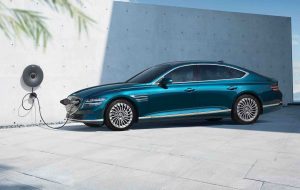
An interesting thing about the G80 electric is that it recharges faster – at home – than the Tesla S, which takes 15 hours to get there using a 240V AC hook-up, which is the most powerful (and “fastest”) hook-up/charging method you can avail yourself of, at home – because private homes do not have the extremely high voltage DC service that can be hooked up to only at commercial “fast” chargers.
Which you have to drive to – and wait there.
You can fully recharge the electric G80 at home (on 240V AC) in nine hours, which means it’s a lot “quicker” than a Tesla S Plaid, in terms of how fast you can get going again.
Another interesting thing about the electric G80 is that it weighs a great deal less than most electric cars of its size, a relatively “light” 5,038 lbs. This is “only” about 500 pounds heavier than the non-electric G80 3.5T (4,497 lbs.) and about 1,000 lbs. lighter than the Mercedes EQE (5,424 lbs.)
But it also much heavier than the Tesla S – which weighs 4,561 lbs. That’s flyweight – for an EV and it accounts for the Tesla’s best-in-class range and quickest-to-60 capabilities.
The G80 electric’s silence – and instant quickness (when called upon) are the only two obvious giveaways that it is electric.
There is no “sound augmentation” – as in the Benz EQE (and the Tesla) to make it sound like something other than just another car. As most luxury cars with engines are also extremely quiet, it would be easy to fool someone who didn’t know this car is electric.
Until you floor it, of course.
What happens then is the main thing that has sold EVs so far. That being the immediate and immense acceleration that doesn’t end until you lift off the accelerator. There is no slight pause in between the time you floor it and the moment it accelerates – as there often is with the latest crop of turbo-engined non-electric cars; it takes a moment for the boost to build before the power comes on. That never happens with electric motors, which spin right now.
Remember, direct drive. No transmission. No shifts. No lag in between them. Just linear – and forceful – propulsion.
But – and there’s always one of those, isn’t there? – it takes a lot of power to get those motors spinning and current-technology EV batteries don’t hold much power, which is why EVs don’t go a far as other cars. A typical EV battery pack can store the electric equivalent of roughly half a tank of gas, or enough to go around 300 or so miles. And there’s a compounding Catch 22 in that in order to store the electric-equivalent of just half a tank of gas, an EV battery must be very large and for that reason, is very heavy.
It’s why even a relatively “light” mid-sized electric car like the Tesla S still weighs more than a full-sized non-electric car and it’s why the electric G80 weighs about 500 pounds more than a non-electric half-on pick-up truck. And much more than a comparably powerful gas-engined car – because even a full tank (say 21 gallons) only weighs about 120 pounds.
And unlike a gas or diesel-powered car, which gets lighter as the fuel is burned, an electric car is always lugging around the full weight of its battery around, even when its battery is nearly empty of electricity.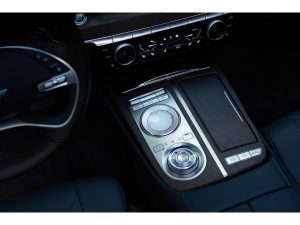
There is something else to know, too.
It is that an EV’s range varies not only according to how you drive it – faster equals less range, as in any other car – but also according to temperature, a factor over which you have no control. Batteries aren’t as efficient in cold weather as in temperate weather; they also lose charge when parked – if not plugged in.
These caveats aside, the electric G80 drives seamlessly- and luxuriously. It is less sporty than the EQE and Tesla S, on purpose. And this is good, in that it’s a difference – which is sorely wanted when dealing with electric cars. The G80’s suspension tuning is soft and that is nice, if you’re wanting to just relax on the way to wherever you’re headed. This is helped – a lot – by the unobtrusiveness of most of the “driver assistance” gewgaws, most of which can simply be turned off. Being harassed by lights and chimes – and a car that tries to parent you as you try to drive it – is neither relaxing nor luxurious.
Genesis seems to grok that, as the sci-fi writer Robert Heinlein put it.
If 7-Up was the Un-Cola, the G80 electric is the Un-EV, stylistically. This is because it’s the same car – almost exactly – as the non-electric G80, other than a few not-obvious differences such as the grill not being functional (for airflow).
But otherwise?
It’s really hard to tell – and that’s good, if you aren’t looking to make a big deal out of the EV-ness of what you happen to be driving. Even inside, the differences are subtle. Almost everything is the same as you’d find inside the non-electric G80, except for the charge meter in place of the tachometer in the main instrument cluster and some EV-specific displays in the 12.3 inch LCD center stack, such as charge monitoring/power consumption.
These exceptions aside, it’s a loaded G80, which means it comes standard with an adaptive suspension, top-of-the-line (21 speaker) Lexicon premium audio system, side shades for the backseat passengers, heated and cooled seats and pretty much everything that is optional in the lower trims of the non-electric G80 and standard in the top-of-the-line G80 3.5T Sport.
Except for the V6 engine – and the panorama sunroof, which for some reason is not available with the electric G80.
As far as vs. its primary electric rivals, there are some commonalities – and some differences. Like the Benz EQE, the G80 has a trunk – like a conventional sedan. For that reason, it has only 13 cubic feet of trunk space, which isn’t much for a prestigious car of this size. The Benz actually has a larger – or rather, more roomy – 15 cubic foot trunk, even though the EQE, itself, doesn’t look as large as the G80 does. Which it does by being both wide and low, whereas the Benz has a more lozengy look.
Both of them are at a functional disadvantage vs. the Tesla S, which has a large-opening hatchback that opens up the entire interior of the car, providing 64.5 cubic feet of total available space with the rear seats down and even with them up (and people sitting in them) you’ve still got 28.1 cubic feet of space.
However, the Tesla also has comparatively cramped rear seats, with 35.5 inches of legroom (vs. 38.2 in the Mercedes EQS). The G80 comes in about the same – as the Tesla – with 35.9 inches of rearseat legroom.
The Rest
If you crunch the numbers, it comes down to this: Going electric – in a G80 – will cost you $14,075. That is the difference in cost for the G80 electric vs. the G80 3.5 T Sport.
It is also a much smaller difference than the difference between an EQE 350 – which stickers for $74,900 to start – and an otherwise similar Mercedes E350 non-electric car, which stickers for $56,750 to start.
It is also a $15,165 difference vs. the Tesla S, which buys a lot of electricity – if you’re looking to save a lot of money, that way.
The Bottom Line
This G80 might be the perfect electric luxury car for the person who doesn’t want to make a big deal of owning an electric luxury car.
. . .
If you like what you’ve found here please consider supporting EPautos.
We depend on you to keep the wheels turning!
Our donate button is here.
If you prefer not to use PayPal, our mailing address is:
EPautos
721 Hummingbird Lane SE
Copper Hill, VA 24079
PS: Get an EPautos magnet or sticker or coaster in return for a $20 or more one-time donation or a $10 or more monthly recurring donation. (Please be sure to tell us you want a magnet or sticker or coaster – and also, provide an address, so we know where to mail the thing!)
My eBook about car buying (new and used) is also available for your favorite price – free! Click here. If that fails, email me at EPeters952@yahoo.com and I will send you a copy directly!


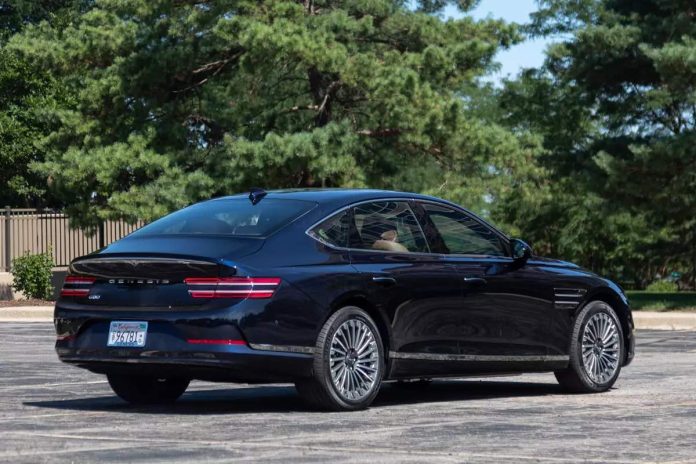

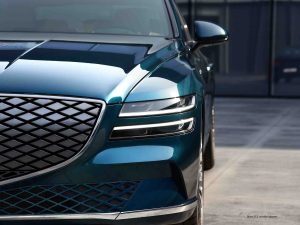
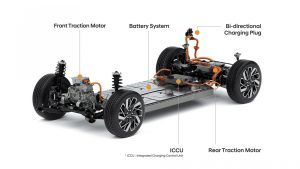
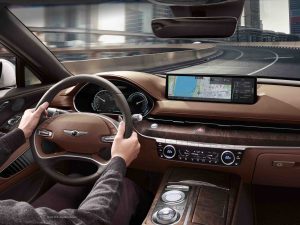
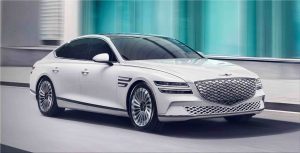
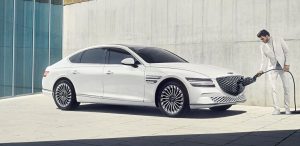








14k extra for the privilege of waiting hours to refuel?
Not a chance in hell!
And not to criticize, Eric, but your “bottom line” doesn’t really make sense, because no reasonable person would want to own an “electric luxury car”.
Hi Markjs,
I try to write my reviews for the person who might be interested in a given vehicle. So in this case I assumed there are people who might want an EV. It’s not me, of course. And that always makes it tough to write about EVs!
Too big a premium for the same car in electric
How come the “indicated” vs “actual” range is always way off? Do these people (who make EV’s) have this “roses & flowers” view of what they think the range of the batteries are, to fool stupid people? Or do they truly not realize how much sucking is involved (power wise) on the batteries? Why can’t they make the indicted vs actual the same, or closer together? And here I was hoping that by the year 2000, we would have George Jettson, no-need-for-wheels kind of vehicles. Instead, the Feds are trying to force us into these stupid things.
The reason is simple. They shade the truth to make it more attractive to the simple minded. In blunter terms they lie. But the simple believe as they have been taught to.
Hi Shadow,
It’s an interesting thins – especially in view of the fact that gas and diesel-powered cars are held to a very strict standard in this regard. If, for example, a car that touted 28 MPG in city driving and 35 on the highway regularly underperformed by 10 percent (or even 5) there would likely be recalls and lawsuits…
“the panorama sunroof, which for some reason is not available with the electric G80.”
Perhaps a rigid structural roof is needed to help support the battery?
Still just another EV, with all the hassle, short life, and inconvenience that entails, which you have to pay extra for. Yes, it will go quickly, for a little while, and then it bricks.
Hi John,
I think you figured it out in re the roof – and you’re right, of course, about the rest…
I stopped at the local Meijer, (Big Box Grocery) in Swartz Creek, MI today. Did some shopping. About a 1/2 hour. Yhey have a Tesla fast charge station. When I drove in there were 3 getting charged. When I drove out they were all still there with one additional. All were sitting in their cars as I drove in and out of the parking lot. I would go insane if I had to do that. It’s bad enough sitting to wait to gas up at Costco. But at least theline moves and 5 minutes per car.
That’s what iPhones are for, to while away the time you spend in queue at the EV charger or waiting for a mass transit system to arrive at your designated stop.
Depressing to see more and more EV reviews, even on this forum.
Guess the die is cast.